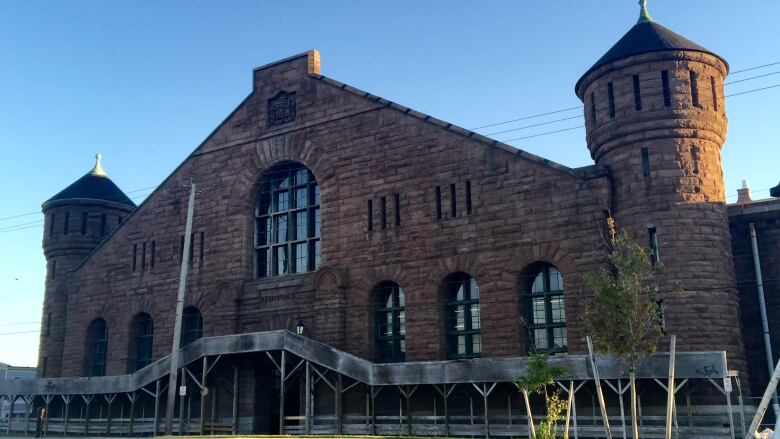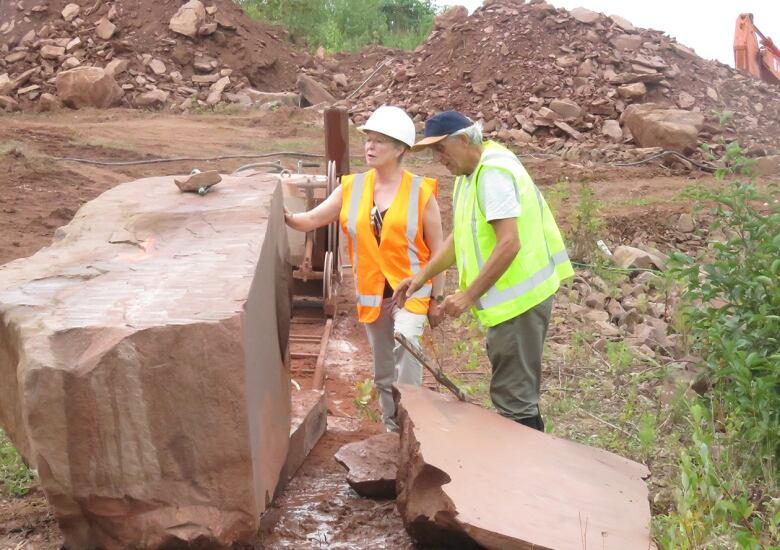$130M renovation will restore the North Park Armoury, 'the poppy on the lapel of Halifax'
1st phase of the project will rebuild the west wall, damaged in the 1917 Halifax Explosion

An ambitious $130-million, seven-year rehabilitation of the historic Halifax North Park Armoury is getting underway.
The Ottawa-led project will ensure the landmark dubbed"the poppy on the lapel of Halifax" survives for another century or more, according to project managers.
"This building is a monument to remembering all those who have gone before and those who will come in the future. So it is like a poppy in our lapel," saidRosanne Howes, the project manager with the Department of National Defence.
Job No. 1: Fix damage from Halifax Explosion
The first phase will rebuild the armoury's west wall, whichfaces the Halifax Commonon North Park Street.
Officials believe it has slowly been tiltingoutward since the building was damaged and later quickly repaired in theHalifax Explosion.

Cables were bolted to the wall as part of the temporary repair but recentlythe lean has been increasing as the building ages.
"Remediation was done at the time to hold it back but the mortar is washing out: the stone is loose. So we are renovating that wall first," Howes said in an interview, speaking from Ottawa.
Kijiji ad helped find sandstone
The red sandstone facade, along with the brick behind it,will be taken down to the foundation and rebuilt.
About 120 tonnes of new sandstone will be required. But achallenge arose in searching forsandstonethat matched.
The original Cumberland County quarry in northern Nova Scotia that provided the stone in the 1890s is long gone.
But thanks to a Kijijiad for a canoe, Procurement Canada was able to find a vein for the original sandstone.

In the background of one of the online ad's photographs,taken on River Philip,was a large, characteristically red sandstone block.
"That's how we came to determine the whole areawas providing different kinds of stones and industry-type capabilities," Howes said. "They would be put on a barge and sent up River Philip, and possibly to the Pugwash stone yard that was mentioned in the original [1890s] records."
Fredericton-based Atlantic Flagstone has set up a quarry just north of Oxford, N.S., to supply the first two phases of the rehabilitation project.
Heritage good for business
The rebuilding of the west wall facade is expected to be completeby October 2019, with the other three walls, roof and interior work ready by 2025.

"We wouldn't have this 130-million-plus dollars cominginto Halifax if we didn't have the military and federal government investing in maintaining this wonderful structure," she said.
Built in 1899, the Halifax North Park Armoury wasat the time the largest uninterrupted space without columns in Canada.
It is home to the Princess Louise Fusiliers, an infantry regiment which traces its roots back to a Halifax militia in 1749, whenthe city was founded.
With its towering turrets, the castle-like Armoury was seen as the crowning achievement of Chief Dominion Architect Thomas Fuller.












_(720p).jpg)


 OFFICIAL HD MUSIC VIDEO.jpg)
.jpg)



























































































